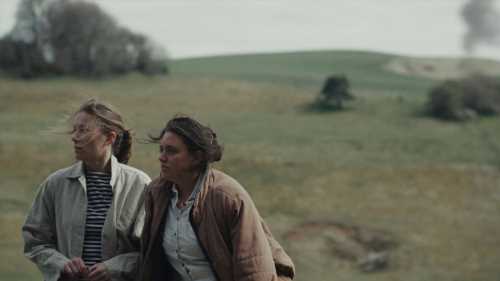Rockets, sickness, progress and the environment – all uneasy keywords of our present.
In Katharina Huber’s “A Good Place” (“Ein schöner Ort”) which won on Saturday Locarno’s best emerging director award and best performance (Clara Schwinning) in the Swiss fest’s Filmmakers of the Present, a remote and untimely village sets the scene for an imminent apocalypse but also for an otherworldly fairytale. Or are these two one and the same?
Huber’s first feature opens with an image of a forest fire, foreshadowing the dystopian tone of an elusive audiovisual journey where emotions prevail over rational explanations.
Set to the rhythm of a countdown, this chaptered story sees Margarita (Céline De Gennaro) and Güte (Schwinning) – two women with contrasting personalities, juggle mundane tasks of daily life with disruptive acts of sabotage. Yet they themselves don’t seem to know what the looming menace is and what they are rebelling against.
People keep mysteriously disappearing. An unknown sickness starts sweeping through the village. As if an omen of a terrible disaster, dismembered parts of chicken appear out of nowhere. How are all these related? Or are they related at all?
The paradoxical pleasure of watching “A Good Place” is that neither the characters nor the viewer are able to make sense of all these strange circumstances. Huber never intended her debut to be conceptual, but rather as a film that speaks more to the senses and is less concerned with the narrative and content. “It was important to do something that doesn’t communicate on a factual level. Something where people would come out of the film with a feeling that they were moved, but without being able to pinpoint the exact sentiment”, says the director.

In the background to all the village’s bizarre occurrences, some eerie radio broadcasts update on an approaching rocket launch. Programs and bulletins feed fragments of political contexts and social policies from a world that potentially exists outside the community, a world seemingly in turmoil.
Drawing on the overarching anxiety that comes with groundbreaking change, Huber explores the conflicting nature of technology and progress. The film confronts the partisans of change and the chronic skeptics, delivering a choral of unresolved contradictions on what the future should be. “Progress can sometimes be reactionary,” underlines Huber, so as to say that there exists a human stubbornness to obsess over advancement and not change direction even upon the realization of an impending doom.
Huber jokes that the over-presence of radio in the film may have come out of her own preference for the medium in terms of staying informed. She listens to a lot of radio for the news. Explaining this preference and briefly touching on the film’s relationship with catastrophic images, the director says, “Images can have such a great influence. There are so many violent and crazy things in the world and I’m sometimes afraid of images.”
As a counterpart to technology, in “A Good Place” there’s, of course, nature. Images of gloomy forests further emphasize the uncanniness of the environment that Margarita and Güte inhabit. Huber suggests that, nowadays, especially in Germany, where she’s based, there seems to be a tendency to want to return to nature. Yet, she says, “I didn’t want to romanticize nature”, opting for a rather direct approach to landscapes, where they are “simply inhabited spaces,” and where beautiful forests can equally feel inhospitable.
“Scenery can be a character itself,” adds the director, emphasizing in her approach a kind of affinity to still lives and idle moments. “I like still lives and the moments in-between, because they have a richness to them. You see an image and that’s exactly all that is happening. There’s no need for too much interpretation.” These images are also essential in creating the rhythm of the film. “It was important that we had these moments of pause and I didn’t want to go from one action to another,” remarks Huber on the necessity of a more atmospheric cadence for the story.
Huber’s debut feature – and, actually, one important first directorial venture into fiction filmmaking after mainly working in animation with award-winning shorts such as “The Natural Death of a Mouse” and “Tangram” – is ultimately atypical for the current German film landscape.
“A Good Place” is as “indie” as an independent film can be. Making use of a modest budget (at least as German films go), Huber’s film also saw her working with a very small team and serving also as a writer, editor and producer. Through her Cologne-based production company Acker Film, Huber demonstrates well-established craftsmanship in various levels of filmmaking that certainly didn’t go unnoticed by Locarno’s Filmmakers of the Present jury.

Read More About:
Source: Read Full Article

